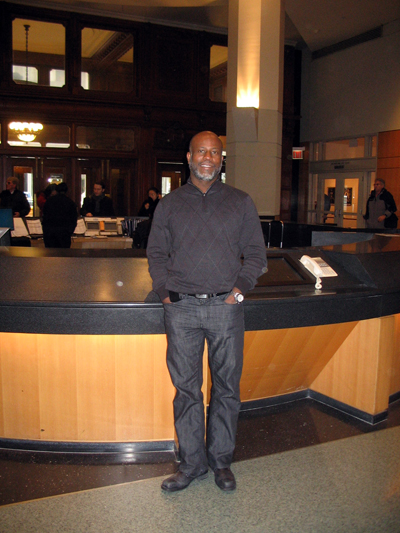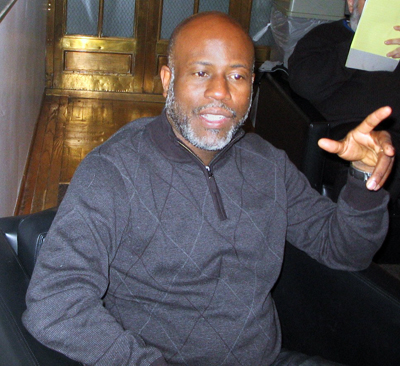The Internet and the long-running recession may have killed the American newspaper, but ethnic newspapers remain very much in business.
In New York, where hundreds of small newspapers serve the city’s diverse communities, the ethnic media stubbornly continues to publish issue after issue, selling copies at cost or just giving them away. The city’s nearly 3.5 million (out of a total population of 8.3 million) immigrant residents largely depend on these newspapers for news, services and entertainment.
Today FI2W begins a series on how these newspapers are adapting to changes in the economy and the revolution in news gathering and distribution.
“The Internet is not the enemy,” declared Haitian Times editor, publisher and founder Garry Pierre-Pierre, in a measured, soft-spoken voice trying to rise above the cafeteria patter at the City University of New York (CUNY).
The Haitian Times, a maverick on the ethnic media landscape in New York, actually began as a fee-based website for readers who wanted news about the Haitian diaspora community. After a few months spent defining its readership and market, Pierre-Pierre published the first print edition in 1999.
As the weekly paper is aimed at Haitian Americans, Pierre-Pierre made the decision to publish it in English with one page devoted to French. His innovative model is the opposite of many ethnic papers in this city which follow the philosophy of ‘print first, web second,’ and are written in languages other than English.
Pierre-Pierre, 48, who shared a Pulitzer for The New York Times’ team coverage of the 1993 World Trade Center bombing, is on the faculty of the CUNY Graduate School of Journalism. He told FI2W he needs to “do other things” besides publishing the Haitian Times in order to provide for his family. Being editor-publisher, although a prestigious title for this seasoned journalist, is not enough.
So as an adjunct professor and newspaperman, Pierre-Pierre divides his time between the CUNY campus on Fifth Avenue in Manhattan and the Haitian Times office in Flatbush, Brooklyn in a decrepit building it shares with a staffing agency, a dance school and a bargain clothing store.
It costs $50 for an annual subscription to haitiantimes.com, while the print version is free and distributed in community centers, stores and public places. Pierre-Pierre’s says for the most part, his readers are second generation Haitian-Americans with access to technology. The website gets an average of 100,000 hits a month. However, there is a segment—”older and more Haitians than American”—who prefer the paper version of the Haitian Times.
“We believe the kind of journalism that we practice should be paid,” said Pierre-Pierre, who is trying to educate readers about the need to pay for quality journalism. “We don’t just rely on commentary, we have reporters on the ground. And that costs money,” he said.
Despite ambitions to pay his staff for high quality journalism produced online or in print, Pierre-Pierre described the Haitian Times operation as “very bare-bones.” A dozen people are involved in putting the paper out week after week. There are no staff reporters—news is reported by freelancers who are paid per story. The administrative staff is paid, but nowhere near a monthly salary. Columnists volunteer their time and professional insights.
“It’s really a labor of love. I don’t get paid. I do other things to feed me and my family,” he said, which is partially why Pierre-Pierre started teaching at CUNY.
Pierre-Pierre isn’t just thinking about how to convey news to the Haitian diaspora, he’s also concerned with building a new journalism model. His view is that what’s in the newspaper shouldn’t necessarily be online. The website and the print edition appear to co-exist as two separate entities, and Pierre-Pierre is proud that his weekly paper and the website complement—as opposed to copy—one another.
“We don’t want to cannibalize ourselves,” he explained. “Unlike all other publications who just put everything on the web, and then there’s only 12 people who pick up the paper, you need to give people reason to go to the website and also to pick up the paper.”
But since the recession began about four years ago, there’s been less money to run the paper. Haitian Times lost $30,000 to $40,000 in annual advertising revenue that it used to receive from New York State, which paid community newspapers to publicize anti-smoking and other public service campaigns. “It’s our biggest hit,” he said.
Small businesses have continued to pay for advertising space because, Pierre-Pierre said, they need the paper’s core audience to reach young Haitian Americans looking to connect with their Haitian heritage. The ads are mostly for airlines and money transfer companies along with classifieds and legal notices. The immigration lawyers who had previously been a significant source of revenue are not advertising in big numbers anymore, Pierre-Pierre noted. Their presence peaked when record-numbers of Haitians were applying for special Temporary Protected Status (TPS) visas that allowed them to stay in the U.S. and work here.
The economic recession seems to have affected readership too: the paper’s circulation has dropped to about 15,000 from a high of almost 25,000 four years ago. Pierre-Pierre attributes the decline to people spending less on media and partly because the paper stopped mailing subscriptions to cut postal costs. But he estimates actual readership to be much higher—45,000—due to people sharing copies among friends and family. If that’s accurate, it would mean The Haitian Times reaches a significant portion of the Haitian immigrant population in New York, which according to the American Community Survey is 128,750. And in spite of substantial financial obstacles, Pierre-Pierre has stubbornly continued to turn out the paper week after week.
The recession may have meant less income for the paper, but Haitian Times managed to survive the recession without any layoffs. The newspaper’s size did not shrink, and the page count remained steady with a constant source of content. Haiti, with its cycles of natural disasters and political upheavals over the past few years has made for no shortage of news. Just last month exiled dictator Jean-Claude “Baby Doc” Duvalier made an unexpected comeback to the island, prompting wonder among the diaspora.
“The Haitian Times is a respected paper,” said Brooklyn native M. Skye Holly, whose family is from Haiti. “It does serve the Haitian community and is able to meet several generations of Haitians.”

Garry Pierre-Pierre, Editor and Publisher of The Haitian Times, at the CUNY Journalism School. (Photo: Cristina DC Pastor)
The fact that the paper from the beginning had a “bare-bones” structure may have actually helped it weather the economic downturn.
“If we lay [people] off we wouldn’t publish any paper. Our operating expenses are not that much, so cuts won’t make a difference,” Pierre-Pierre said.
“One of the ways we survive is through special events,” he continued, recalling a music festival they initiated about 10 years ago that brought in a flood of sponsorships and readers. Haitian Times is currently organizing three events in Brooklyn, where many Haitians live—an art exhibit, a business seminar, and a luncheon honoring women in the community—hoping to earn modest revenue for the paper.
Wrestling with a new journalism model for ethnic media has been a learning process for Pierre-Pierre. While he says the website is “fairly popular,” it has not picked up the volume of advertising generated by print. Pierre-Pierre had the vision to adopt a fee-based Internet newspaper business model way before mainstream newspapers and the perseverance to stick with it, but the community he’s serving hasn’t entirely kept pace with his embrace of technology.
Yet despite the shaky finances and a drop in readership, Pierre-Pierre is confident that Haitian Times will be “well positioned” once the economy improves, having put in place an integrated web-and-print media organization. He believes that as long as the people who run the paper get some form of compensation, the paper, in both its online and print versions, will press on.
“We’re not on strong ground, never been on strong ground, but we’re OK,” he said. “We operate from the margins. There are no fats, so when the lean time comes, we just roll with it.”
Cristina Pastor is a Feet in Two Worlds business and economics reporting fellow. Her work, and the work of other Fi2W fellows, is supported by the New York Community Trust and the John S. and James L. Knight Foundation with additional support from the Mertz Gilmore Foundation.





